Shooting audience sitcom has all kinds of unique production problems compared to other types of television.
After all, any TV show has to decide whether to shoot a given scene on location, or in the studio. Each choice has advantages and drawbacks: you don’t have the expense of building a set on location, but you also have less control than in a studio. With audience sitcom, though, you start running into further problems. Is there room in the studio for that extra set in front of the audience? And yet if it’s a dialogue-heavy scene, surely you want to do it in front of the audience, so the actors can play off their reaction?
Squaring this particular circle can lead to some interesting results. Let’s take a look at three of them.
* * *
Til Death Us Do Part, “To Garnett A Grandson” • BBC1 • 13th September 1972
Oh dear, what’s Alf up to this week? Answer: complaining that he has to travel to the hospital in order to see his just-born grandson.
ALF: Look, I’m not saying anything about going up to see my daughter, am I? And my grandson. I want to go up there. All I’m saying is they could have put her a bit more nearer, somewhere a bit more convenient like.
ELSE: It don’t matter where it was, how far, it’d still be inconvenient for you.
ALF: Look…
ELSE: I remember when I had Rita. It was six days before you come to see her. And I was only upstairs.
Oh Alf, stop being a dickhead.
Now Johnny Speight being Johnny Speight, he manages to cause the production some issues with how he tackles this story. We don’t just have Alf moaning in the living room, cut to a brief location shot of the hospital, and then have him continuing to moan as he walks into the ward. No, Speight wants to see Alf moaning throughout the entire journey to the hospital. A total of eight minutes of screen time.
Which is all very well, but in 1972 for an audience sitcom, it was far easier – and cheaper – to do dialogue like that in the studio rather than on location. So what does the show do? It does a few film inserts on location, and recreates the rest of the journey in the studio.
Being an enclosed space, this works OK for the bus stop, although the cut from the studio on VT to location film is inevitably a little jarring:
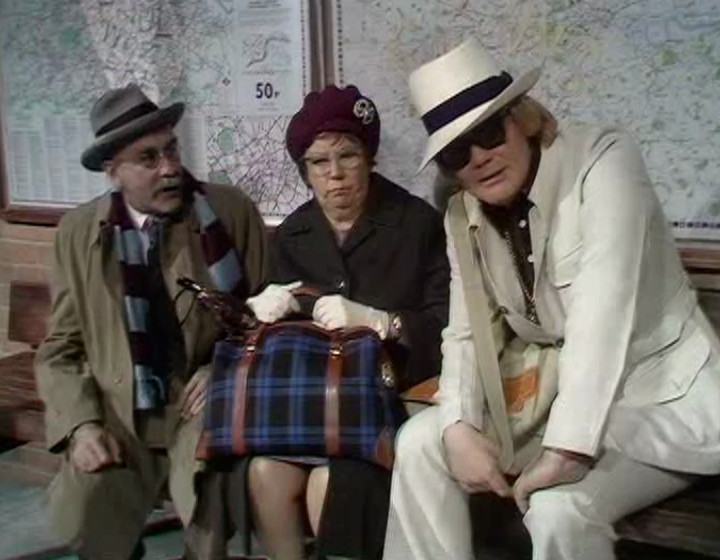
Studio
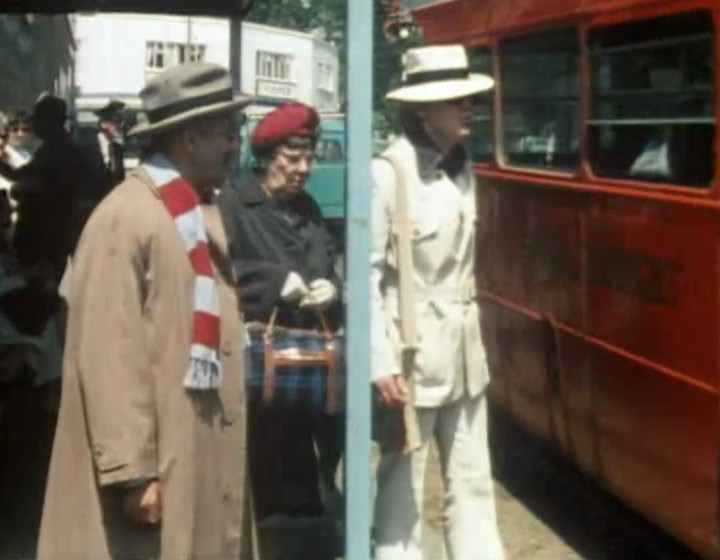
Location
As for this conversation underneath an umbrella, which starts off on film and then cuts to a CSO shot done in the studio, it’s perhaps best filed under “nice try”:
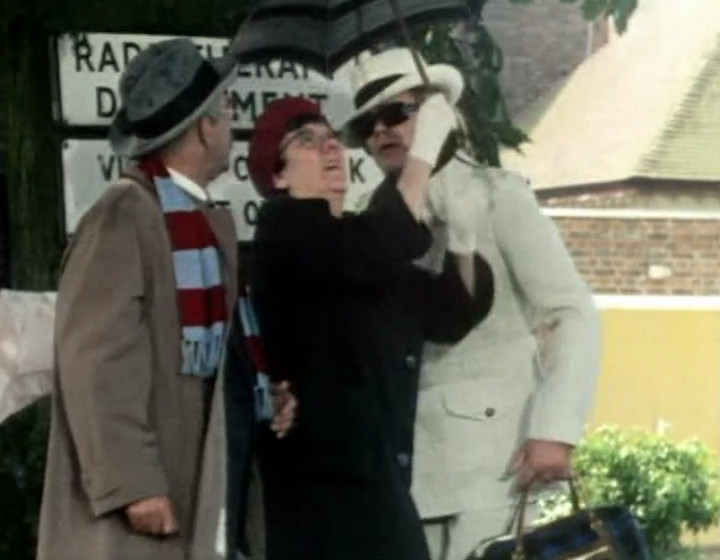
Location
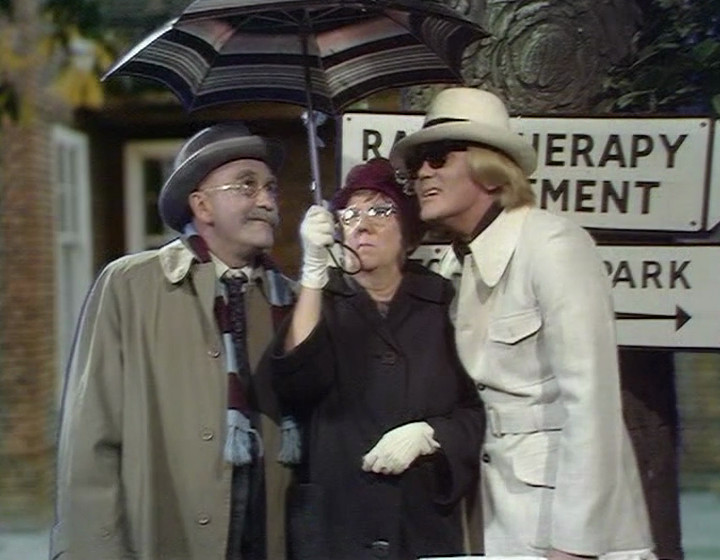
Studio
To get the full effect of this cut, it’s worth watching the video:
You do feel a certain amount of sympathy for the production here; I’m not sure transplanting eight minutes of dialogue into a grotty BBC film sequence of the time would have been any improvement. I’ll take getting the comedy right and living with the slight oddness. Speight should probably have rewritten most of this dialogue to take place at home, before they even started the journey.
But if a programme from 1972 isn’t allowed to be vaguely experimental in its production, what is?
* * *
I’m Alan Partridge, “A Room with an Alan” • BBC2 • 3rd November 1997
25 years on, and all that oddness is gone. In the very first episode of I’m Alan Partridge, there is a perfect example of how you can combine studio and location work effectively so people can’t spot the join. Yes, it’s Alan’s trip round his potential new house, the one with the “Buck Rogers toilet”:
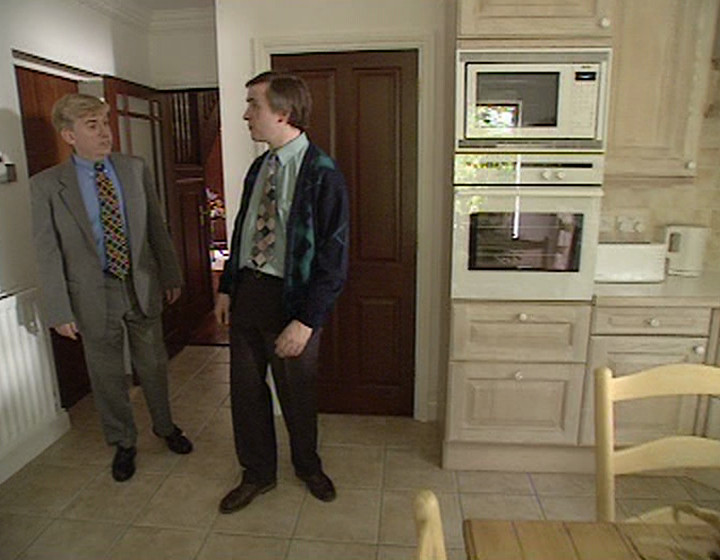
Location
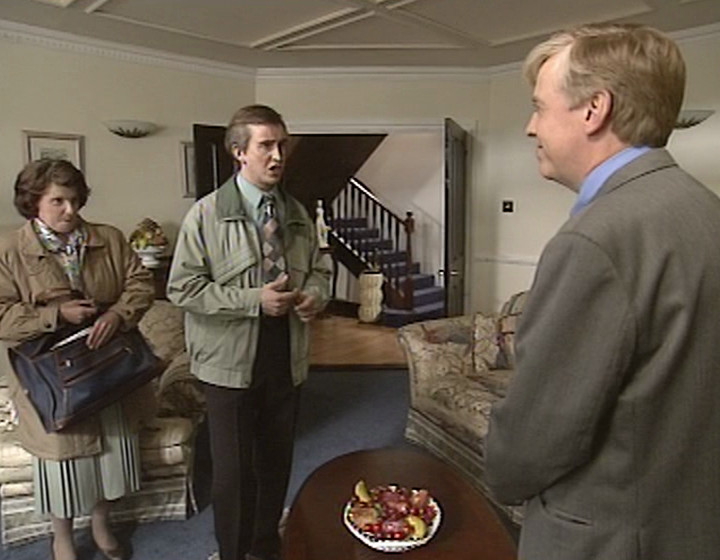
Studio
The DVD commentary reveals some of the thinking behind this:
IANNUCCI: This set is in the studio, but the stuff that happens straight after it, when Alan goes round the rest of the house, is on location. So this is one of those points where we had to try and match up the lighting of a location with the studio.
COOGAN: And we used the same lighting man for location and studio, to match it. Because normally, there was a huge difference between location and studio.
IANNUCCI: Usually you can tell when you’ve gone from location to studio on a sitcom when you hear the phrase “Dah-dah-dah…” And then you know you’re in the studio.
The difference between Till Death and this is stark; I think plenty of viewers who were technically-minded still wouldn’t have a clue that half this scene was studio, and half location. Obviously, the transition from a mix of film/video, to purely video is a huge factor, as is the lighting as mentioned above.
But one other thing makes it more convincing than what we see in Till Death. There’s another example of the location/studio mix later on in the episode, at the BBC restaurant:
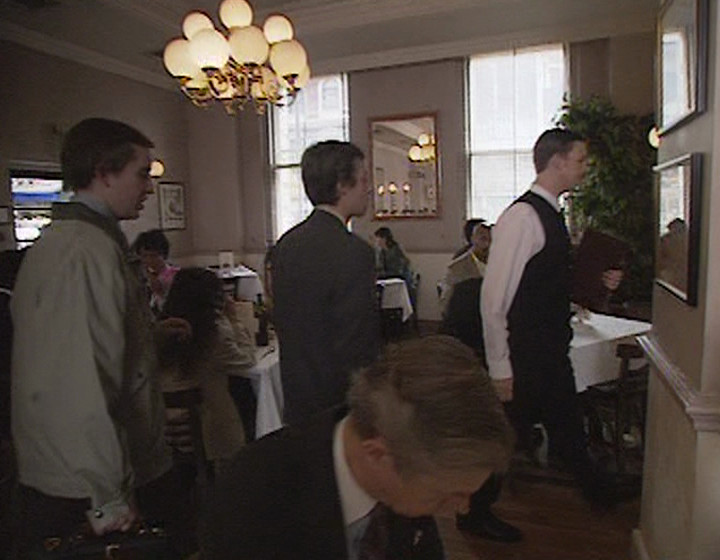
Location
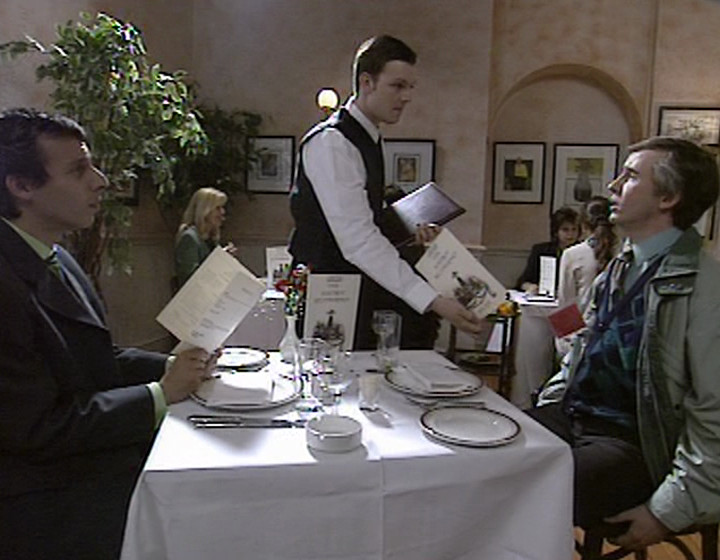
Studio
Alan and Tony go round the corner on location, and seamlessly enter the studio set in front of the audience. Meaning you can sell the wider sense of the restaurant without building a huge set, and yet still do your big dialogue scene with the studio audience present.
But one reason all this is seamless: unlike Till Death, you’re not asked to accept two different representations of the same space as the same thing. The kitchen of Alan’s potential new house is on location, but the living room is in the studio. Similarly, one part of the restaurant is on location, but the section with Alan’s table is in the studio. There simply isn’t the jarring effect of having to accept two different versions of Alf and company hunched under an umbrella.
The question is: is it possible to do what Till Death attempted… but done right?
* * *
Keeping Up Appearances, “Hyacinth Tees Off”1 • BBC1 • 22nd September 1991
The weird thing about Keeping Up Appearances is that its broad reputation among comedy fans as a series which was running out of steam is unwarranted. In fact, it’s the final series of the show which has some of its strongest episodes, and it’s the show’s sophomore series which has some of the weakest.
This episode is from that second series, and while there are far worse half hours to spend with Hyacinth, the most interesting aspect of the episode is technical. Set in a country hotel, it features none of the usual standing sets for the show. It’s a rare episode indeed which doesn’t feature Hyacinth’s house, even just briefly.
For the technical goss, let’s turn to Producer/Director Harold Snoad’s quite amazing book, It’s Bouquet – Not Bucket!, which I highly recommend spending an absurd amount of money on. Snoad tells us TV nerds what we REALLY want to know:
“The reception area, corridors and bedroom we needed for this episode were built in the studio but we also required the use of a large lounge for Hyacinth to go round testing the various settees and armchairs, not only for comfort but to ensure that they had been dusted to her satisfaction. We didn’t have enough space left in the studio for such a large set to be erected so I needed to film this element on location.
The Chesford Grange Hotel2 didn’t have a lounge that would be suitable but, in the course of our location recce, my production manager and I called into the Regent Hotel in Leamington’s main street. The lounge was perfect and they were happy to let us film there. In reality, I only did the material that involved Hyacinth wandering around checking the furniture – watched by two fascinated guests – on location. My designer at that time (Tim Gleeson) then reconstructed one wall of the lounge in the studio. This was used for the dialogue elements of the scenes when Hyacinth sat down and started to bore the couple rigid by talking about her husband’s important job with the council – a great exaggeration – and by showing them photographs of Sheridan. We had taken the sofa and the chairs we were going to use in the studio element with us to the hotel so the continuity was right. Even the most discerning viewer would be hard pressed to see where the studio element of the lounge took over from the real thing on location.”
In other words: here, we have an example of a combination of the techniques used in Till Death and I’m Alan Partridge. We have the video location/video studio approach of I’m Alan Partridge, along with their care taken to try and match both types of footage properly… but like Till Death, it’s also asking the viewer to accept two different representations of part of the hotel as the same physical space.
Does it manage it?
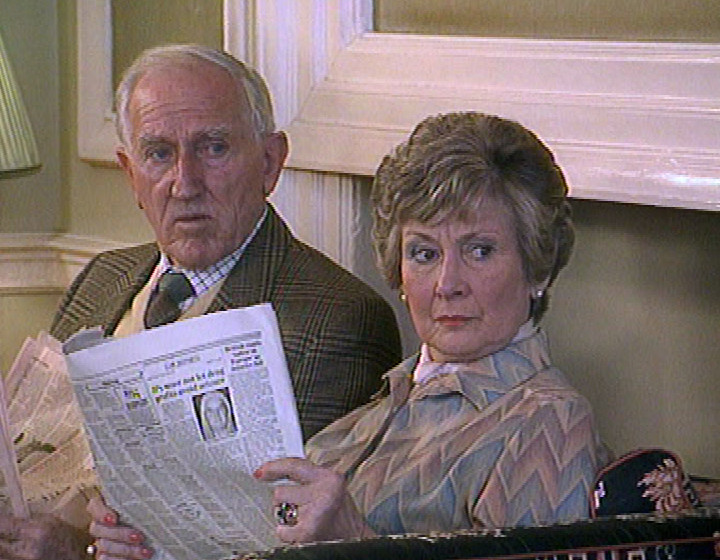
Location
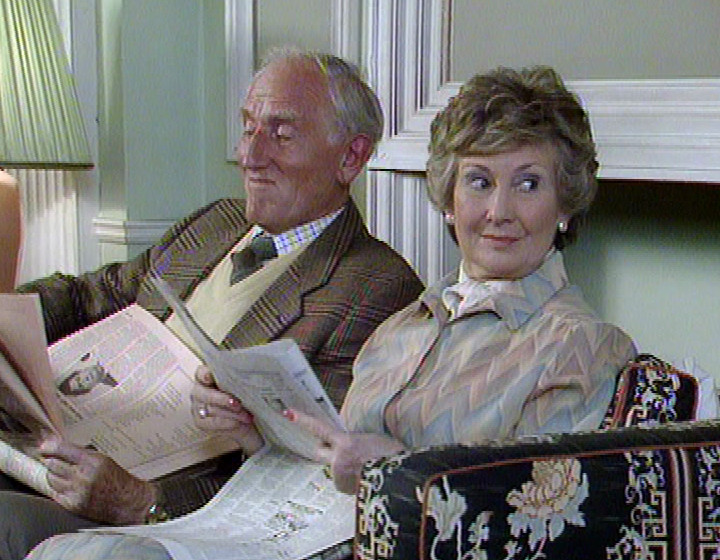
Studio
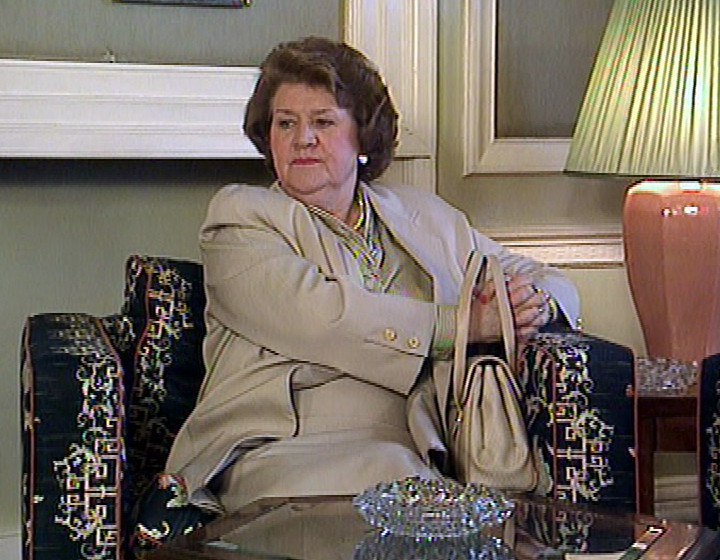
Location
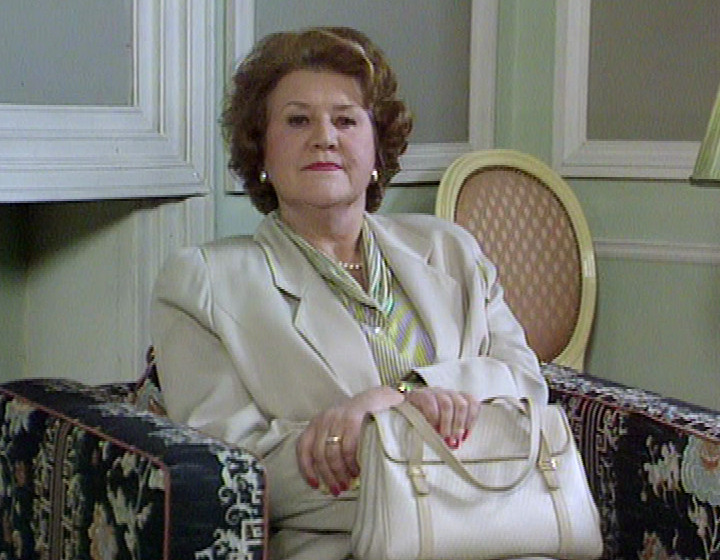
Studio
At first glance, perhaps the pictures above look slightly strange. When placed side-by-side, all you can see are the differences in picture texture and fittings. But you get a better sense of how the scene works when watching it properly:
And I have to be honest: I consider myself fairly sensitive to this stuff… and I had absolutely no idea when I watched this episode what they’d done. I think I just assumed that it was all location; I had no idea that part of it was in the studio at all. If it’s obvious now, it’s only obvious because Harold Snoad told us about it.
But this is the kind of thing audience sitcom was doing in the 90s. Pushing the boundaries of what an audience sitcom actually meant. Instead of obvious studio sequences interspersed with obvious location material, sometimes it attempted to blend the two in interesting ways, in order to tell the story in the best way possible.
Among comedy fans, I’m Alan Partridge often gets credit for this, because everyone loves talking about Alan Partridge, and Iannucci’s DVD commentaries are always interesting. But let’s give Keeping Up Appearances its due as well. A show which is clearly more traditional, but doing very interesting things within that framework.
And if nobody noticed… well, that was the point.
The bulk of this article was written before the death of Harold Snoad was announced. It seems appropriate to dedicate it to his memory, considering the piece is all about how clever he was. I suspect he would have liked that.

12 comments
steve on 4 June 2024 @ 12pm
I read that unit location hotels can come in very handy for film crews, even on movies
whilst filming the empire strikes back, and the scenes on Hoth, the snow planet, a white out stopped them getting to their location so they literally filmed some of it in the hotel car park, with the building behind the film crew, in a blizzard nobody would know the difference.
Jonny Haw on 5 June 2024 @ 11am
Excellent article! I can’t help but feel that Till Death cut could have been a lot smoother if they’d continued the ambient background sound. Would still have looked ropey, but a lot less jarring.
Steve Williams on 7 June 2024 @ 9am
That Till Death edit really makes me chuckle, it is absolutely ludicrous.
I wonder what the last show was that had its exteriors shot on film as a matter of course, rather than it being a stylistic thing (I know One Foot in the Grave was still shooting on film into the nineties, but as you illustrate, Keeping Up Appearances was using video for exterior scenes in 1991, so seemingly the option was there). I looked at an episode of the kids science show Knowhow recently and that was entirely shot on film, including the links between the items from the office, and that was in 1990 which seems surprisingly late.
Nathan on 10 June 2024 @ 3pm
I feel like 1990/91 is the change over point of VT Studio/Film outdoors. Summer Wine went all VT for Series 13 in 1991 before going the other way to all film (though assembled on tape til around 1995), even Benny Hill’s last program ‘World Tour: New York’ from 1991 was done entirely on VT, and that’s a show where film was a part of it’s iconic look.
John J. Hoare on 10 June 2024 @ 6pm
The big question is: which is the LAST audience sitcom to shoot its exteriors on film?
I *think* it’s the final episode of Only Fools and Horses from December 2003.
Martin O'Gorman on 11 June 2024 @ 2pm
Conversely… I’m making my way through David Brunt’s Doctor Who Production Diary for the Hartnell Years and was surprised to see that Head Of Plays Gerald Savory pitched a proposal in May 1966 that the Drama department at the BBC should look into using videotape instead of shooting exteriors on film.
Savory investigated getting hold of an OB unit exclusively for drama use, but the idea didn’t seem to progress much further. This seems very early for that sort of thing (and, as Brunt notes, Dr Who didn’t embrace the idea until 1974), but then I remembered Granada’s The Corridor People from the summer of ’66 had locations shot on video. And there’s a lovely clip out there of a Play School being shot on location in June 1968.
Interesting, innit?
John J. Hoare on 11 June 2024 @ 3pm
It is. And that reminds me – I must watch The Corridor People again.
A rare example of a show where you have no idea what the format of the show is after the first episode. (And let’s be honest, not much more idea after the fourth and final one.)
Martin O'Gorman on 12 June 2024 @ 4pm
I watched the Network trailer for The Corridor People and that was baffling enough for me.
I forgot to mention why Gerald Savory was pursuing an “all VT” agenda. The memo says: “It is wrong for any drama production to be composed of studio output together with film. […] It is wrong to have to match film and studio and with film cameras, directors see what they are doing in terms of tiny pictures. There should be no film stage use: the only inserts should be on location and OB cameras to keep these on the same life-size scale as the studio part of the production.”
What does he mean by “life-size scale”?
In any case, I’m not sure if the average viewer cared to any great extent. I knew, aged five, that when The Goodies left their office, something different was happening in terms of picture quality; at one point I convinced myself that “outside” looked different in real life.
Certainly, Python respected their audience’s intelligence enough to do the “Good Lord… I’m on film” joke – and I was savvy enough about TV production in 1985 to laugh at it when it was released on VHS.
Keep up the good work!
John J. Hoare on 13 June 2024 @ 10pm
I have to admit, I have some sympathy for Savory’s concerns. The goal to make your programme feel technically coherent and all of a piece makes sense. And at least he wasn’t trying to go for an “all film” agenda, which really would have been boring.
In practice… I kinda like the video/film mix. It stops my eyes getting “bored”, which I know sounds ludicrous, but I can’t think of a better way to describe it. A variety of textures in a show keeps me interested, even if those textures draw your attention to production differences. Of course, some programmes – like The Fast Show – take this, and turn it into something that can be justified creatively as well as practically.
Martin Fenton on 15 June 2024 @ 2am
The Til Death jump makes me wonder whether the scene was rewritten after filming.
There is an episode of Van Der Valk (the one with Lalla Ward in) where a couple of sequences which should have been on film ended up being done back in Teddington, with some pretty crummy CSO in the museum sequences. I worked with one of the Dutch crew years later, and he told me that it was because of a wildcat strike. One of the Thames technicians touched one of the Dutch crew’s plugs or something, and the episode had to be finished in London. Shortly after that, Euston Films was formed, and they had a somewhat more relaxed attitude to Trades Unionism.
Finally, I’ve long wondered how much of Dennis Waterman’s house in On The Up was studio and how much was location. It’s a pretty massive set.
John J. Hoare on 15 June 2024 @ 9pm
If I recall correctly, the OFITG episode “The Wisdom of the Witch” has at least one pre-record day, and then *two* audience recordings. Very lavish. I have no way of proving it, but I highly suspect that one audience recording had all the usual sets for the Meldrews’ house, and the other has all the Aunt Ursula country house sets. They’re huge, I don’t think it’d all fit in the studio without two sessions.
Darrell Maclaine on 17 June 2024 @ 10am
Probably the largest-scale version of this idea is The Brittas Empire, which took it to extremes by reverse engineering a main standing studio set at TVC that would perfectly match the location used for OB set extensions, and took invisible switching to new levels. That idea of creating a complete geography where you can have a world – too big for just a studio, too complicated for just a location – that expands to utilise the full power of both. And another example of how standard definition PAL was an amazing canvas for artistry and illusion that we all merrily sacrificed on the altar of electronics manufacturers.